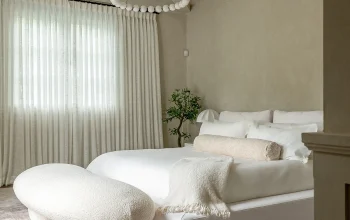Your bedroom is more than just a place to sleep. Honestly, it’s your sanctuary, your command center, your personal retreat. But a one-size-fits-all approach to decorating it? That just doesn’t work. The needs of a college student cramming for exams are worlds apart from a remote worker on back-to-back Zoom calls or a senior looking for comfort and safety.
Let’s dive into how to tailor a bedroom for these three distinct life stages. We’re talking about creating a space that doesn’t just look good, but truly works for the person living in it.
The Student Sanctuary: Maximizing Space, Minimizing Budget
For students, the bedroom is a multi-tasking powerhouse. It’s a dorm room, a study hall, a social spot, and, oh yeah, a place to catch a few hours of sleep. The core challenge? Doing all of this in a tiny space with an even tinier budget.
Smart, Space-Saving Furniture is Key
You have to think vertically. Lofted beds or ones with built-in desks underneath are absolute game-changers. They free up precious floor space for a small seating area or just, you know, walking around. A storage ottoman at the end of the bed serves as extra seating, a footrest, and a hiding spot for textbooks and laundry.
And don’t forget the wall—a simple pegboard above the desk can organize everything from school supplies to headphones, turning chaos into a kind of fun, functional art installation.
Lighting for All-Nighters (and Morning Classes)
A single overhead light won’t cut it. You need layered lighting. A bright, focused desk lamp is non-negotiable for studying. Then, add some softer, ambient lighting—think string lights or a cheap floor lamp with a warm bulb—to make the room feel cozy when the textbooks are finally closed. It helps signal to your brain that it’s time to wind down.
Personalization on a Dime
Personality is what turns a sterile room into a home. Removable wall decals, a gallery wall of printed photos, or a colorful, textured rug can inject a ton of character without damaging dorm walls or breaking the bank. It’s all about those easy, rental-friendly upgrades.
The Remote Worker’s Retreat: Where Productivity Meets Peace
When your bedroom also serves as your office, the lines between work and rest can get dangerously blurry. The goal here is to create a clear physical and mental separation within the same four walls. It’s about designing a space that supports focus during the day and allows for genuine disconnection at night.
Carving Out a Dedicated Work Zone
If possible, position your desk so your back isn’t to the door—it just feels better. A small room divider, a tall bookshelf, or even a strategically placed plant can visually separate your “office” from your “bedroom.” This psychological trick is powerful. When you step around that divider at 5 PM, you’re effectively “leaving the office.”
Investing in Ergonomics
This is where it pays to spend a little. An ergonomic office chair is worth its weight in gold for your back and posture. A monitor stand to raise your screen to eye level can prevent neck strain. Your future self will thank you. These aren’t just decor items; they’re tools for well-being.
Mastering the Art of Ambiance
For video calls, lighting is everything. A simple ring light can make you look professional and awake, even after a late night. Noise-canceling headphones are a lifesaver for focus. And after work, a good essential oil diffuser with lavender or eucalyptus can help reset the room’s atmosphere from stressful to serene.
The Senior’s Haven: Prioritizing Comfort, Safety, and Accessibility
For seniors, the bedroom becomes a central hub for comfort and security. The decor focus shifts dramatically from style-first to safety-first, but that doesn’t mean it has to be clinical or impersonal. It’s about creating a beautiful, supportive environment that promotes independence.
Furniture that Supports and Protects
An adjustable bed can make a world of difference for reading, watching TV, or managing health conditions. A bed frame that is the right height—not too low, not too high—makes getting in and out much easier and safer. Swap out a low, soft armchair for a firm chair with sturdy arms to assist with sitting and standing.
Lighting to Navigate with Confidence
This is crucial. You need bright, overall lighting to eliminate shadows and dark corners. But you also need targeted, low-level lighting. Motion-sensor night lights that automatically illuminate the path from the bed to the bathroom are an absolute must-have. It prevents fumbling for switches in the dark and reduces the risk of falls.
Decluttering and Flooring Fundamentals
Keep pathways wide and clear. Remove loose rugs that can bunch up or slide—they are a major tripping hazard. Ensure all carpets are securely tacked down. Opt for non-slip mats on hard floors, especially in areas that might get damp. It’s these simple, practical choices that make a bedroom not just comfortable, but truly safe.
Quick-Reference Guide: Key Decor Considerations
| Demographic | Top Priority | Key Furniture Piece | Lighting Focus |
| Student | Space & Budget | Loft Bed / Storage Ottoman | Task Lighting for Studying |
| Remote Worker | Work/Life Separation | Ergonomic Chair & Desk | Ring Light for Calls & Ambiance |
| Senior | Safety & Accessibility | Adjustable Bed / Sturdy Chair | Motion-Activated Night Lights |
At the end of the day, the most successful bedroom decor isn’t about following the latest trend. It’s about honest, thoughtful design that serves the person in the room. It’s about creating a space that supports their daily life, their unique challenges, and their personal sense of peace. Because a room that truly fits is a form of self-care, no matter your age or stage in life.




